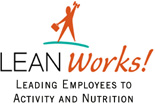Environmental and Policy Strategies
Environmental and policy strategies address the entire workforce and populations (not individuals). The strategies target physical and organizational structures through developing worksite and public policies that support healthy behaviors. They are likely to be sustained for a longer period of time than individually oriented strategies.42
Promising Practice: Enhanced Access to Opportunities for Physical Activity Combined With Health Education
Enhanced access to opportunities for physical activity combined with health education are practices that enable or facilitate access to physical activity programs, workshops, classes, and other resources in a worksite setting.
Evidence of Effectiveness
We identified five studies43-47 that evaluated the effectiveness of enhanced access to opportunities for physical activity combined with health education. All five studies measured a percentage relative change in a weight-related outcome, with a median effect size of −3.24%.
Examples of How These Strategies Were Implemented
Description: The intervention43 was an exercise course centered on the using a par course nearby. The course had 19 activities along a 1.5 mile course which allowed for strength and aerobic activity involving brisk walking and jogging and exercise-related information was distributed. Incentives were given to groups who had the most individual participation in exercise. Incentives included heart healthy lunches, t-shirts, and tickets to local sporting events.
Duration: 4 months
Location, Gender, Industry Setting: US, Males Only, School
Human Resources: Staff and volunteers of Stanford University's Health Improvement Program
Financial Resources: No charge to employees, incentives donated
Description: This cardiovascular risk reduction program was offered through the Medical Department's Corporate Wellness and Fitness Service Unit. Medical screening, fitness assessment, exercise prescription, and structures support are the four main components to this program. Employees complete an application for membership which includes a medical questionnaire, an exercise history, goals for exercise, and a medical clearance form. Certified exercise physiologists examine applications and those at high risk are referred to internists. A voluntary fitness assessment and exercise prescription is offered using certified testing procedures. An exercise physiologist conducts one-on-one meetings (structured support) to review the results and discuss and provide health education, reading materials, orientation to the Fitness Center, and other introductory information. Intramural athletic contests are also offered daily.45
Duration: 6 months
Location, Gender, Industry Setting: US, Males and Females, Company
Human Resources: Certified exercise physiologist, certified internist
Financial Resources: Not reported
Description: Structured and Non Structure Exercise in a Corporate Wellness Program
The Corporate wellness program consisted of two groups, Structured Exercise program (planned exercise classes) and the Non-structured exercise classes (free access to exercise facilities and encouragement to exercise) Individuals in both groups had access to educational sessions (nutrition, exercise, lifestyle modification, and disease prevention) and materials on nutrition, exercise, lifestyle modification and disease prevention. They could also get social support and annual check-up on 5 selected physiologic variables.46
Duration: 12 months
Location, Gender, Industry Setting: US, Males and Females, Company
Human Resources: Staff of the wellness committee
Financial Resources: Not reported
Additional Resources
 How to Develop a Wellness Challenge: Worksite Wellness Challenge Toolkit (PDF-2Mb)
How to Develop a Wellness Challenge: Worksite Wellness Challenge Toolkit (PDF-2Mb)
Provides procedures on how to organize a wellness challenge in your worksite.
Audit Tool
This tool will help you assess the walkability of your workplace.
How to Provide Healthy Snacks and Lunch at Meetings (PDF-1.07Mb)
Washington State Guidelines to Help Energize Your Meetings
Provides a list of recommended foods and beverages and menu suggestions to enhance access to healthy foods at meeting.
How to Implement Healthier Options in the Cafeteria and Vending Machines* (PDF-360k)
The New Hampshire Department of Health and Human Services Health Promotion in Motion will help you implement healthier options in your worksite's cafeteria and vending machines.
Simple Steps to Ordering Farm Fresh Produce for your Worksite (PDF-221k)
Provides information on how to Order Farm Fresh Produce for the Worksite.
How to Create a Garden Market
Help your employees increase their fruit and vegetable intake. Learn how to create a fresh produce market at your worksite.
Also in This Section
![]() Please note: Some of these publications are available for download only as *.pdf files. These files require Adobe Acrobat Reader in order to be viewed. Please review the information on downloading and using Acrobat Reader software.
Please note: Some of these publications are available for download only as *.pdf files. These files require Adobe Acrobat Reader in order to be viewed. Please review the information on downloading and using Acrobat Reader software.

Contact Us:
- Centers for Disease Control and Prevention
1600 Clifton Rd
Atlanta, GA 30333 - 800-CDC-INFO
(800-232-4636)
TTY: (888) 232-6348
24 Hours/Every Day - cdcinfo@cdc.gov

